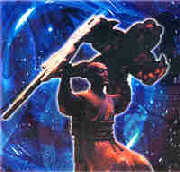In the late Ming Dynasty, the rockets with double boosts were also produced. At the rear of the rockets, there were four gunpowder boosters. These two features resembled the basic characteristics of the rockets nowadays. The weapon could fly for a few miles above water. What's more, three other kinds of rockets with double boosters that used recyclable body were also invented, which greatly inspired the research and development of modern rockets.
 Not only were the rockets used in the military domain in the Ming Dynasty; there were also men's attempts to fly together with the rockets. The scholar Wan Hu in the Ming Dynasty, who is regarded as the originator of the manned rockets, was the trailblazer in doing experiments aimed at taking human being to space.
Not only were the rockets used in the military domain in the Ming Dynasty; there were also men's attempts to fly together with the rockets. The scholar Wan Hu in the Ming Dynasty, who is regarded as the originator of the manned rockets, was the trailblazer in doing experiments aimed at taking human being to space.
On the basis of his research about the boosting power generated by the rockets, he made a chair with 47 rockets, the maximum number that could possibly be tied to his chair. He tied himself to the chair, and held two bigkitesin each of his hands. Then he asked his assistants to fire the fuses of the 47 rockets at the same time, hoping to fly in the sky with the boosting power from the rockets and the kites.
Though doomed to fail, Wan Hu has been universally acknowledged as the first man to try flying to space with the help of rockets. In memory of Wan, one of the lunar craters on the back of the moon is named after him.
Around the end of the 13th century and the beginning of the 14th century, Chinese inventions of powder and rockets spread to India, Arab, and in turn, Europe. With centuries of development and application, rocketry began to be used for spatial exploration after World War Ⅱ.
Despite the fact that powder and rocket were first invented in China, the ancient rocketry failed to develop into modern rocketry due to longtime neglect in science and technology. Consequently, powder and rocket were only used in fireworks for centuries.
